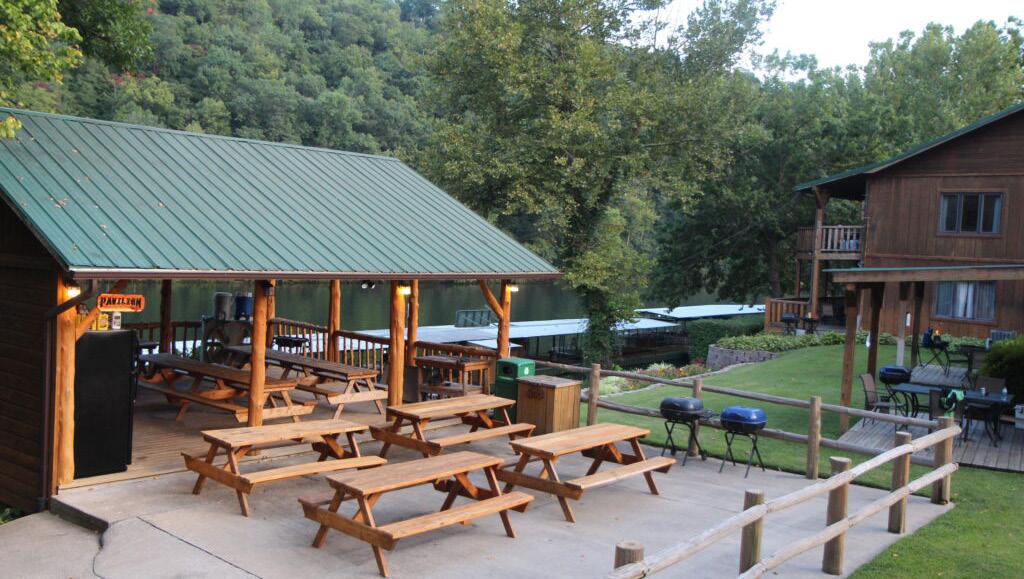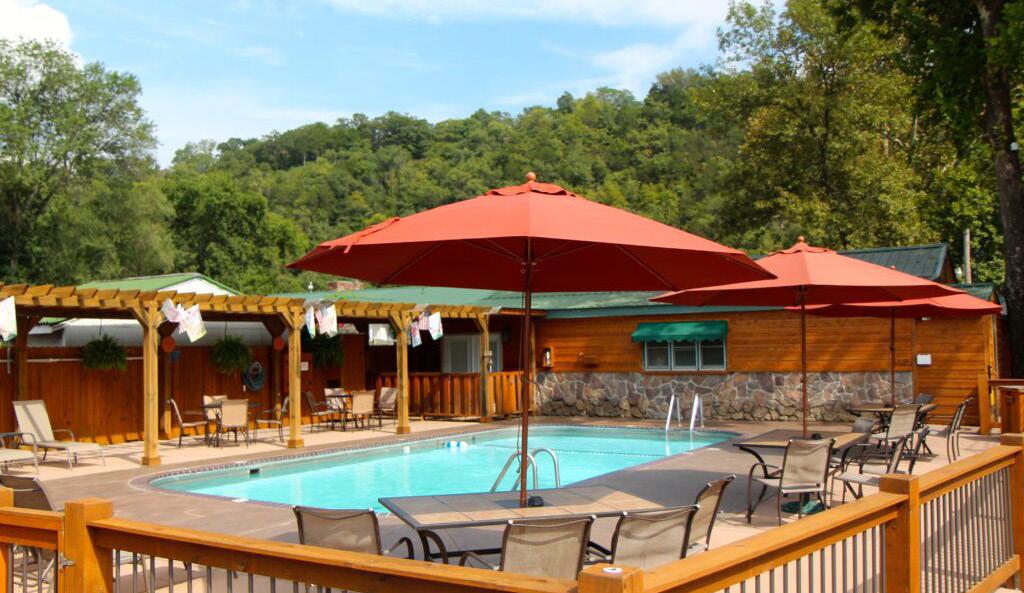
8 minute read
Good Karma on the Upper Jacks Fork
Good Karma on the Upper
Jacks Fork
As spring continues to emerge, the urge to get on the river starts flowing in my veins the way sap rises in maple trees. My heart begins longing for a trip on the Upper Jacks Fork, a stretch of river that is often too shallow to paddle in the summer. As I think of journeys past, one from a few years ago rises to the surface; it was full of river karma, from the Prongs to Rymers.
The Prongs to Buck Hollow
The trip was organized by the Ozark Wilderness Waterways Club (www.owwckc.org), of which I'm a member even though I live on the eastern side of the state, and the club is primarily based in the Kansas City area. The planning involved a good deal of stopand-start flexibility. With all the raining and flooding that spring, the trip was on again, off again, until we grabbed a few sunny days between a flash flood and more rain in late April. The river gods were smiling upon us, with blue sky, warm sun and the rosy hue of redbuds just starting to bloom.
Our small flotilla of canoes – both tandem and solo – and one kayak set off from the South Prong access at the Highway Y bridge, northwest of Mountain View. As soon as we rounded the corner, the first challenge came into view -- the big culverts we needed to pass through. A root wad blocked one, probably a result of the recent flash flood, so we sailed through the only open option. Looking back after we passed through, we could see the culverts for the North Prong; the two branches of the river join at this point.
The upper 25 miles of the Jacks Fork is truly beautiful, with a canyon-like feeling because of the narrow riverbed and the towering limestone bluffs, often on both sides of the river. The section from the Prongs to Buck Hollow (Highway 17 bridge) is 6.8 miles, which makes for a leisurely day's float.
Leaves were just beginning to unfurl, giving trees a spring-green halo. The pink of redbuds and the white of serviceberry popped up along the bluffs and through the woods. The water was crystal clear and deep, and the river banks were carpeted with Virginia bluebells. Turtles basked in the sun on logs and rocks. We spotted osprey, bald eagles and a heron.
Two other groups were floating and fishing this section of the river, and we leap-frogged one another, as some stopped for breaks or to cast a line and others paddled on. The one constant companion the entire day was a young dog who swam tirelessly back and forth across the river and trotted alongside on gravel bars. She would join one group, then another, and we all thought that she was with one of the other boats.
Gradually we realized that she was not with any of us but was on her own on the river. Because she seemed like she knew her way around, most thought she would go home on her own. But when we arrived at Buck Hollow that afternoon and she was still with us, almost seven miles away from where we had started, I checked her tags for numbers and began making calls.
Her owner was relieved to learn where her 14-monthold Lab-Shepherd mix was and immediately drove to Buck Hollow to pick her up. "She's definitely a river dog," she said with a laugh.
Most of the group headed for home that afternoon, but Barbara Van Vleck, of Lee's Summit, and I spent another night at the primitive campground at Rymers, listening to the whippoorwills, owls and frogs. At the same time, we sat beside a campfire under a starry sky and an almost-full moon.
Buck Hollow to Rymers
The next day we put in at Buck Hollow and headed for Rymers, a 9.4-mile trip. My goal was to find the natural arch in the Jacks Fork Natural Area that had been featured in the April 2013 issue of Missouri Conservationist. It turns out that everyone else seemed to have the same idea, as paddlers kept asking if anyone knew any landmarks. Soon we spotted Jam Up Cave on the bluff ahead, which meant we had passed the arch without spying it.
Jam Up Cave, between Blue Spring and Rymers, is one of the most spectacular geological sites in the state. The main entrance, high on the cliff but visible through the trees from the river, is an arch about 80 feet high and 100 feet wide. The cave is now closed to visitors because of White Nose Syndrome, a disease that harms bats. But when I visited the cave years ago, it was possible to hike into the cavern, scramble over big boulders and see the underground waterfall and pool. Some people even swam in the cold cave water, but I was too chicken to do that. The cave is a natural tunnel and includes a sinkhole, dome and various passageways; access varies with the water level, which changes within the cave.
After lunch on the gravel bar across from the cave, we had just rounded a bend when we came upon two canoers waving in distress. They had flipped their heavily loaded canoe in the rapids and one had cut his hand to the bone. With a solo kayak and a solo canoe, we couldn't give the injured guy a ride, but we helped as well as we could, then paddled ahead to Rymers to drive to the top of the hill and try to get a cell phone signal to call for help.
At Rymers, we discovered that the sign marking the takeout point had washed away in a flood. We worried that the young men might not recognize the gravel bar, so we crafted a homemade sign and attached it to some sticks near the shore. We drove up the hill, called their canoe outfitter and the injured man's fiancée, and then drove back to the gravel bar, where the canoe had just arrived.
Everything fell into place as we took the two young men to the emergency room at Mountain View, and simultaneously the folks from Two Rivers Canoe Rental came to gather their boat and gear and then collect the paddlers at the hospital. They were scheduled for a four-day float, with takeout at Two Rivers, so their trip was cut short. After a few stitches in his hand, he and his buddy headed back to Iowa. When we checked with him a few days later, all was well, and he was heading to Las Vegas to be married. They couldn't thank us enough for our help, and we just said to "pass it forward."

As we pulled into Buck Hollow to transfer my kayak from Barbara's car to mine, a shuttle from Windy's Canoe Rental drove by. "Maybe he'll help us unload my kayak," I joked. Before we could get out of the car, the shuttle driver from Windy's pulled up beside us and jumped out to give us a hand.
The river gods were still smiling on us. Good river karma. Pass it on.
Barbara Gibbs Ostmann
Lilleys’ Landing Resort and Marina: Paradise on the Water
Driving down the crowded Branson strip, you feel the stress of the workweek hot on your heels. As you turn off the strip and navigate the winding mountain roads towards the banks of Lake Taneycomo, you feel the stress start to fade in the rearview mirror. Out the windshield, you stare down a long, gently sloped pasture at the end of which you are met with the stunning sight of green roofs covering well-kept log cabins. The scene is perfectly placed against the backdrop of a 300-foot cliff overlooking the crystal-clear water of Lake Taneycomo.

Pulling into the newly paved parking lot, you are impressed with the level of care Phil and Marsha Lilley have put into Lilleys’ Landing Resort & Marina. Being in business for 37 years, it’s no surprise that the cabins are top-notch, the swing sets and pool are well-kept and ready for your family to use, and all the trash cans are emptied and clean.
Entering the bait shop to get your room key, you are greeted with more fly fishing and spin fishing gear than you could hold in your tackle box. You look at the cedar-lined walls and marvel at the 40LB+ Brown trout. Even if you are not an experienced trout angler, you feel at ease knowing Duane Doty, the local guide that works with Lilleys’, is going to show you how to catch them in one of Lilleys’ 2017 G-3 bass boats!
Walking back to the room, you are stunned at how quiet it is. Although Lilleys’ Landing is only two miles from the strip, it feels much further. Passing the common area, you notice picnic tables and benches where other guests are swapping fishing stories. The sense of community Lilleys’ Landing promotes is very evident. You are excited to get out on the water and catch a few stories of your own to share!
The quality of the rooms is the real test of any hotel or resort. As you open the door, it’s clear that Lilley’s has passed with flying colors. The beds are neatly made with clean sheets. The carpet is recently vacuumed, and the bedrooms and bathrooms are spotless, with clean towels and extra sheets ready to use. The fully furnished and functional kitchen is ready to go, complete with pans and utensils to cook your trout.
(Top) The picnic area overlooking lake Taneycomo. (Bottom) The pool area with cabins in background. (Photos: Courtesy of Lilleys' Landing)

As you make your way to the back deck of the waterfront rooms, any stress you had dissipates. You’re granted an outstanding view over the neatly mowed lawn down to the new dock, equipped with heated fish cleaning stations, certified scales to weigh that record book Brown you hope to catch. The clear water flows by as you look across the lake at a pair of otters playing on the opposite shore.
When your trip comes to a close, you will be beyond thankful you decided to stay at Lilleys’ Landing. With all the other options out there, Lilleys’ is by far the best with their clean facilities and amenities, and the friendly staff make you feel right at home.








